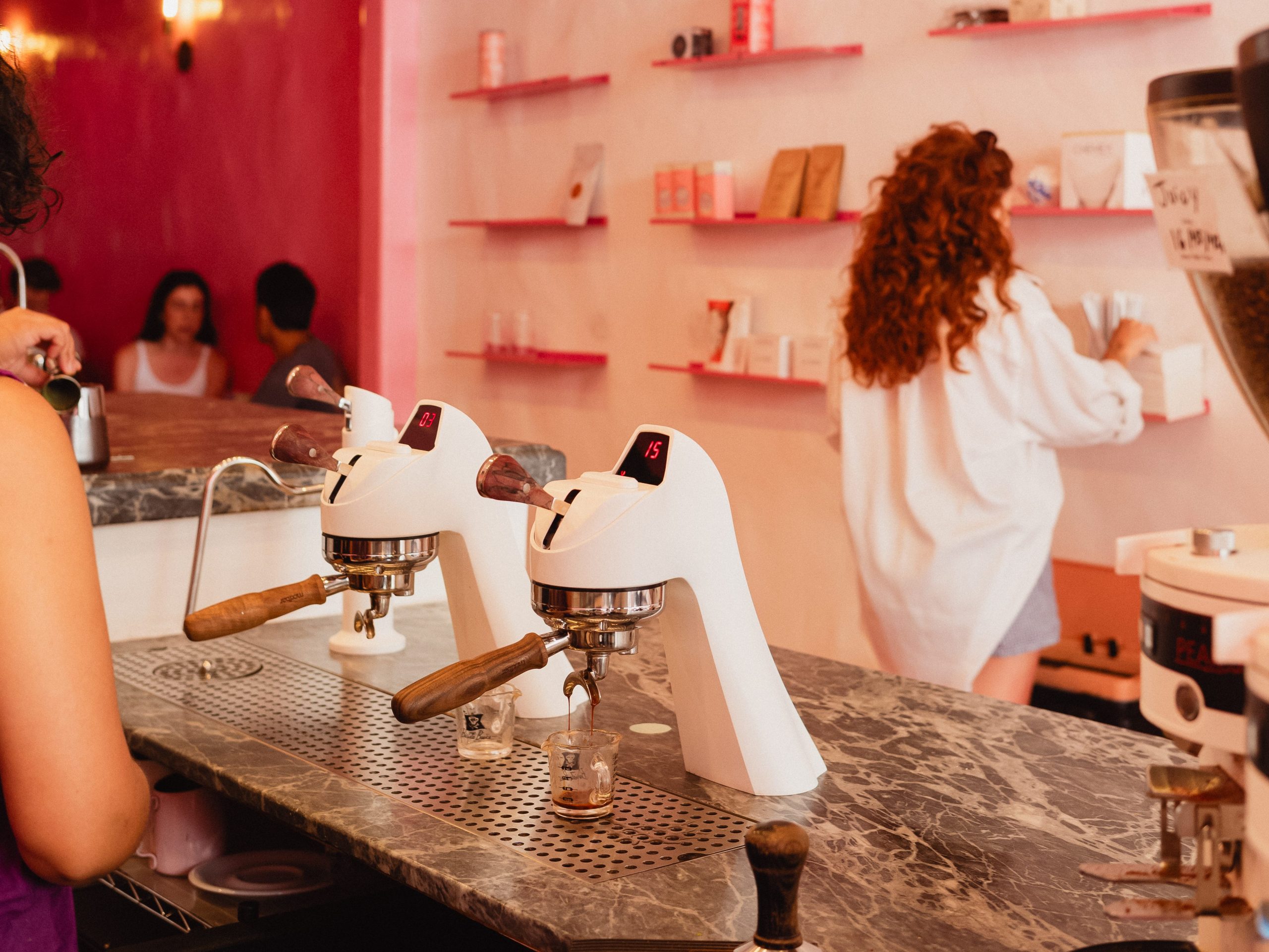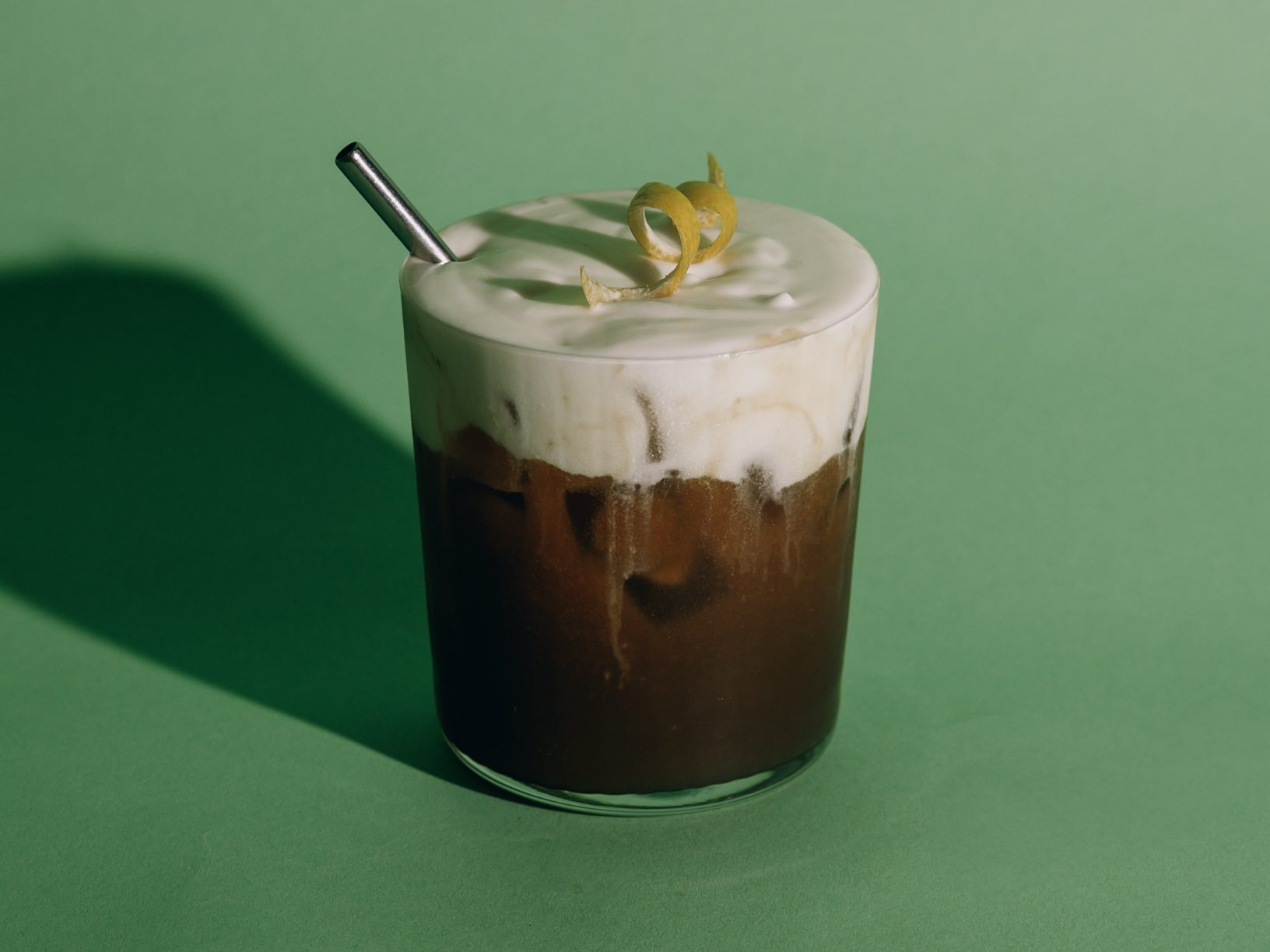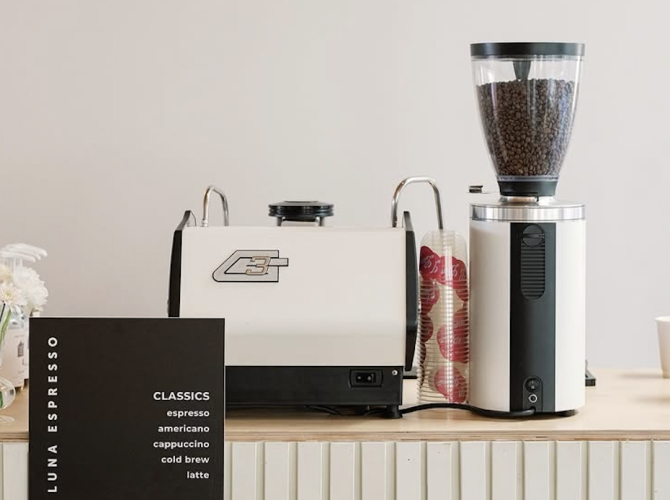Destination Drinks are any specialty or signature beverage that turns a cafe into a destination. Whether it’s a chilled lemonade for summer or an autumnal latte for the fall, these drinks help drive new customer traffic and create new regulars.
Interview by Jordan Michelman and La Marzocco USA.
From the food to the music to the bars to the coffee, Chicago is a place that truly knows itself. You can’t mimic it or recreate it in other places. It’s wholly unique—and can sometimes feel resistant to outside influences.
So when Dayglow Coffee—originally based in Los Angeles, now with five cafes nationwide—first opened in Chicago in 2020, the challenge bar was set pretty high. Chicago brands might expand to LA, sure, but are LA brands coming to Chicago? Founder Tohm Ifergan sees it differently. “Chicago is my hometown,” he tells us. “I’ve always considered this cafe our flagship.”
From design to execution to the experience of sitting in the finished space, Dayglow have established themselves as one of the premier cafe brands in American coffee today. At the crux of this cafe flow is their ongoing partnership with Modbar, whose unique undercounter espresso systems have helped Ifergan and his team create instantly memorable, recognizable cafes.
Dayglow is also well-known for its extensive signature drink menu that draws plenty of attention with flashy colors and exciting flavor profiles on its Instagram page. As a former bartender, Ifergan relies on unique techniques to create complexity in his menu. We learned more about Modbar and Destination Drinks in the interview below.

Hi Tohm, thanks for talking with us. Dayglow now has multiple distinct coffee bars in different cities. How does the city, or the neighborhood of the city, feed back into how you think about cafe design? How do your cafes reflect the identity of where they’re based?
Although our bar approach is quite uniform, the environment in which they sit varies from location to location. Since we use monochromatic colors for each store, the feeling of each space is unique. Thus far, we have only opened cafes where one of us currently or previously lived. That’s been pretty important for us to get a deeper sense of the surrounding community. We like to embrace the character of the neighborhood/building we’re in. Notably, we like to use accordion-style doors whenever possible. This is not only for the open-air space it creates but also to connect directly with the neighborhood around us.
For Chicago specifically, please give me a brief history of that cafe. When did it open? Can you please tell us more about the space where it’s located, what have been the challenges and strengths of the space thus far.
We opened in the fall of 2020 in the Kimball Arts Center in Humboldt Park. What drew us to this location was its proximity to the 606 trail that sits adjacent and overlooks the building. It used to
be a large warehouse space with an archery range that more recently evolved into a modern creative workspace with several new offices. Our architect at Range Design, whom we have since worked with for all our cafes, also designed the building’s remodel. Since they have their office upstairs, it made the build-out process a bit easier to manage from afar during COVID. Others have since moved in, such as our friends at Crop to Cup importers. Additionally, we moved our e-commerce headquarters there in 2022. Even though it’s mostly in a quiet neighborhood without any commercial business around us, we were able to build a wonderful community there.

You guys are increasingly working with Modbar. It’s now at your flagship (or at least I think of Sunset Blvd as your flagship; that may be my own bias), and it’s in Chicago as well. What is it about the Modbar system that fits your cafe model there? Why are you going with Modbar to more of your cafes across the country?
I’ve always considered Chicago our flagship because it’s my hometown and the foundation of what Dayglow is today. This was the first cafe we ever designed from scratch, and it was my first opportunity to build my dream bar. I wanted a long singular bar with everything accessible and organized under the counter. No back bar to collect clutter and closed matte cabinetry to maintain a clean line of sight from anywhere in the space. Only what was absolutely necessary to live on the counters. Clean minimalism to contrast the warm creamy backdrop. Modbar is the only machine that ever made sense for what I wanted to create.
Since the first day we opened in Chicago, I knew it would be the only machine I could ever work with at Dayglow. So we now use Modbar at all five of our cafes as well as the two locations we’re currently building out.

Do you find your guests are still surprised by the Modbar? Do you have questions about it? Are people like…confused? Delighted? Surprised? A little bit of all those things?
I think, as an industry, we’ve become too enamored by the spectacle of the big espresso machine sitting on the counter. What has been most refreshing for most of our guests is that Modbar kind of disappears. Instead of a showpiece, it becomes almost an extension of the barista in front of them, taking a backseat from their experience. I had thought initially that guests would think we might not even be a coffee shop at all. It turns out that when you remove the big machine, you allow for the rest of our space to feel more balanced.
From a workflow perspective, how does designing your cafe for Modbar impact how you think about cafe workflow? I’m especially interested in this for the Sunset cafe — when you switched to Modbar there, what changed behind the scenes for the baristas?
I can’t praise enough how much of a positive impact Modbar has made on that cafe. It opens that entire space to allow us to actually see and engage with our customers throughout the process and serve into the gaps between group heads that previously didn’t exist. Particularly in an area that can often bottleneck, it’s been a revelation.
Who are you guys now? How do you think about your brand? You’re a roaster, you’re a multi-roaster, you have cafes — how do you describe what Dayglow is in 2024?
As you mentioned, we have evolved quite a bit over the years. From relaunching our d2c subscription to our first microbrewery, we continue to expand more ways to make your day ( or nite) glow. Dayglow at its core is a brand of creations and curation, designing experiences around coffee. It uses color to communicate an emotional connection to flavor and spaces. It celebrates the work of our peers as much as our own. It allows our guests to discover as we discover.

How does Dayglow design signature coffee drinks for each different location?
I create a menu annually inspired by the work of my favorite filmmakers. Each beverage is designed around a single film from their catalog. We then maintain a mix of our most popular features from past menus that are most popular. It’s the most important part of our business, what sets us apart from other cafes, and the primary driver of revenue.

What is the most important thing to consider when designing a new signature coffee drink?
I’ve always emphasized BEV: Balance (Is there a good ratio of fat to acid to sweetness?) Execution (Are you executing each ingredient to its absolute best?Are they competing?) Volume (What is the drink experience like? Does the vessel add to or subtract from it?). My favorite is our latest release, inspired by Sofia Coppola’s film The Virgin Suicides. It is a clarified milk punch made from distilled peach co-fermented coffee, peach shrub, oolong, and lemon. It has a creamy mouthfeel and balanced yet expressive flavor.

How often do you think a signature coffee drink menu should change?
It’s common practice to change menus based on season but I’ve found more success doing minor changes throughout the year alongside our annual release. It gives the staff enough time to learn and execute and myself enough time to develop more complex drinks.
Visit Dayglow Coffee’s website and follow them on Instagram.






